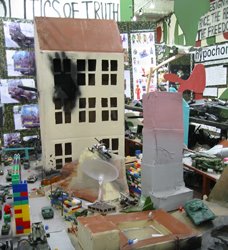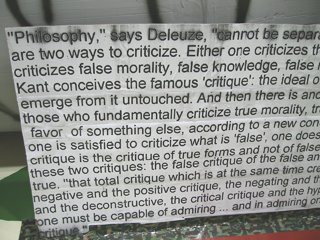 At the CCA Wattis Institute, there is an exhibition by the Swiss born, Paris-based artist Thomas Hirschhorn that will close in two days, on May 13th. I had meant to write about it earlier but kept postponing because I wanted to address the armature of theory on which the exhibit is supposedly based. I’ve concluded that life is too short for that, so here are my on-the-fly impressions.
At the CCA Wattis Institute, there is an exhibition by the Swiss born, Paris-based artist Thomas Hirschhorn that will close in two days, on May 13th. I had meant to write about it earlier but kept postponing because I wanted to address the armature of theory on which the exhibit is supposedly based. I’ve concluded that life is too short for that, so here are my on-the-fly impressions.The show is titled “Utopia, Utopia = One World, One War, One Army, One Dress.” If I were a drag queen, I’d be saying, “One dress? Oh sugar, here take one of mine.” But I digress. The exhibition seems like a parody of the conceptually driven program at the Wattis. At the entry, you can pick up a text-heavy, 51-page booklet. It contains a forward by the curators, an analysis by a Stanford art professor (with 23 footnotes), an artist’s statement, and a 28-page essay (with 112 footnotes) by a young German philosopher, Marcus Steinweg, who is a favorite of the artist. This is the most pretentious show I’ve seen in quite some time.
 Visually, the show is a helter-skelter installation of sculptures, models, mannequins, enlarged text fragments from the Steinweg essay (photo above), photographs, drawings, painted blobs in camouflage colors, and miles of camo tape. This material covers every wall and the floors too. And it fills both floors of the Wattis space. The show looks thrown together, even junky (photo below), although not from lack of practice—a version of the show was presented at the Boston ICA last fall. Some of the material is visually interesting: the mannequins, for example, with their disease-like bulges of camo tape.
Visually, the show is a helter-skelter installation of sculptures, models, mannequins, enlarged text fragments from the Steinweg essay (photo above), photographs, drawings, painted blobs in camouflage colors, and miles of camo tape. This material covers every wall and the floors too. And it fills both floors of the Wattis space. The show looks thrown together, even junky (photo below), although not from lack of practice—a version of the show was presented at the Boston ICA last fall. Some of the material is visually interesting: the mannequins, for example, with their disease-like bulges of camo tape. There are some fun ways to look at the show. First, as noted by the curators, it is “loosely inspired by rural French military museums,” so it can be viewed as a wacky museum. Second, with its run-amok ambiance, the show can be enjoyed as a tantrum. Finally, it could be seen as look inside the brain of someone whose thinking has been hyper-caffeinated by postmodern theory.
There are some fun ways to look at the show. First, as noted by the curators, it is “loosely inspired by rural French military museums,” so it can be viewed as a wacky museum. Second, with its run-amok ambiance, the show can be enjoyed as a tantrum. Finally, it could be seen as look inside the brain of someone whose thinking has been hyper-caffeinated by postmodern theory.Camouflage is the visual theme of the show, and it appears as if Hirschhorn is trying to turn a massive annoyance with camouflage-as-fashion into the fanciful idea that such fashions could lead to world unity if everyone wore them. Well, ah, didn’t China have a go at this during the Cultural Revolution?
The artist’s intellectual rationale for the exhibit could be shredded in a freshman seminar. It would take a graduate seminar to pick apart Marcus Steinweg’s essay. I won’t even attempt it. It includes endless sentences such as “The hyperborean subject is the hyperbolic subject of self-transgression and self-surpassing toward an absolute exterior that is Uninhabitability itself, Chaos, Incommensurability as such.” Dude, I’m sure!

No comments:
Post a Comment